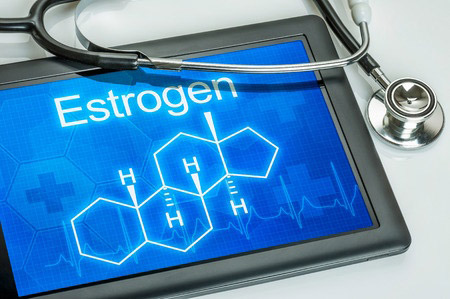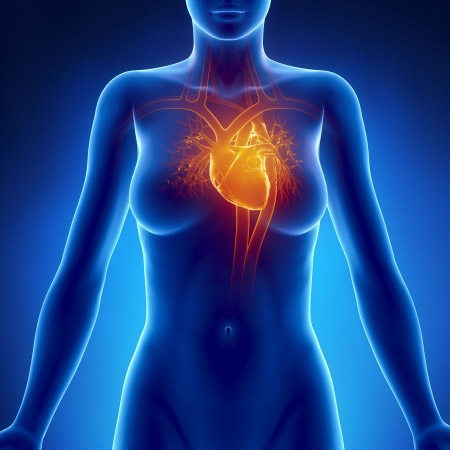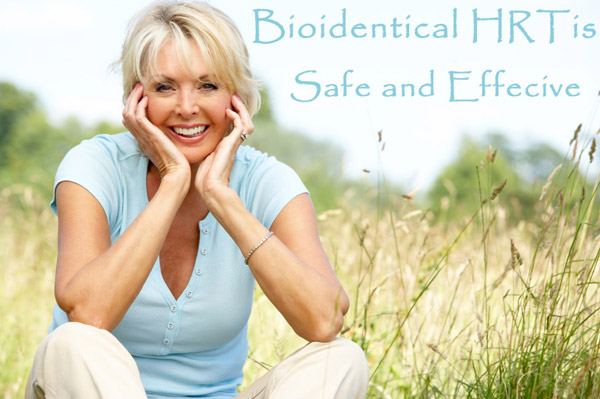Bioidentical HRT - safe and effective treatment of menopausal symptoms
Estrogens
Bioidentical Estradiol vs. Non-bioidentical CEE (Conjugated Equine Estrogens)


Progesterone
Bioidentical Progesterone versus Progestin (a non-bioidentical progesterone version)


Symptomatic Efficacy of Bioidentical Progesterone vs. Synthetic Progestins

Summary
1. Greendale, G.A., et al., Symptom relief and side effects of postmenopausal hormones: results from the Postmenopausal Estrogen/Progestin Interventions Trial. Obstetrics and Gynecology, 1998. 92(6): p. 982-8.
2. Morris, E.P. and N. Burbos, Menopausal symptoms. Clin Evid (Online), 2010. 2010.
3. Barnabei, V.M., et al., Menopausal symptoms and treatment-related effects of estrogen and progestin in the Women's Health Initiative. Obstetrics and Gynecology, 2005. 105(5 Pt 1): p. 1063-73.
4. National Institutes of Health State-of-the-Science Conference statement: management of menopause-related symptoms. Annals of Internal Medicine, 2005. 142(12 Pt 1): p. 1003-13.
5. Rossouw, J.E., et al., Risks and benefits of estrogen plus progestin in healthy postmenopausal women: principal results From the Women's Health Initiative randomized controlled trial. JAMA, 2002. 288(3): p. 321-33.
6. Anderson, G.L., et al., Effects of conjugated equine estrogen in postmenopausal women with hysterectomy: the Women's Health Initiative randomized controlled trial. JAMA, 2004. 291(14): p. 1701-12.
7. Masood, D.E., et al., Impact of sex hormone metabolism on the vascular effects of menopausal hormone therapy in cardiovascular disease. Curr Drug Metab, 2010. 11(8): p. 693-714.
8. Dubey, R.K., et al., Hormone replacement therapy and cardiovascular disease: what went wrong and where do we go from here? Hypertension, 2004. 44(6): p. 789-95.
9. Pisha, E., et al., Evidence that a metabolite of equine estrogens, 4-hydroxyequilenin, induces cellular transformation in vitro. Chem Res Toxicol, 2001. 14(1): p. 82-90.
10. Chen, Y., et al., A metabolite of equine estrogens, 4-hydroxyequilenin, induces DNA damage and apoptosis in breast cancer cell lines. Chem Res Toxicol, 2000. 13(5): p. 342-50.
11. Wang, Z., et al., Estrogen Receptor {alpha} Enhances the Rate of Oxidative DNA Damage by Targeting an Equine Estrogen Catechol Metabolite to the Nucleus. J Biol Chem, 2009. 284(13): p. 8633-42.
12. Zhang, F., et al., Equine estrogen metabolite 4-hydroxyequilenin induces DNA damage in the rat mammary tissues: formation of single-strand breaks, apurinic sites, stable adducts, and oxidized bases. Chem Res Toxicol, 2001. 14(12): p. 1654-9.
13. Chen, Y., et al., The equine estrogen metabolite 4-hydroxyequilenin causes DNA single-strand breaks and oxidation of DNA bases in vitro. Chem Res Toxicol, 1998. 11(9): p. 1105-11.
14. Peng, K.W., et al., Unexpected hormonal activity of a catechol equine estrogen metabolite reveals reversible glutathione conjugation. Chem Res Toxicol, 2010. 23(8): p. 1374-83.
15. Davison, S.L., et al., Androgen levels in adult females: changes with age, menopause, and oophorectomy. J Clin Endocrinol Metab, 2005. 90(7): p. 3847-53.
16. Moskowitz, D., A comprehensive review of the safety and efficacy of bioidentical hormones for the management of menopause and related health risks. Altern Med Rev, 2006. 11(3): p. 208-23.
17. Dubey, R.K. and E.K. Jackson, Estrogen-induced cardiorenal protection: potential cellular, biochemical, and molecular mechanisms. Am J Physiol Renal Physiol, 2001. 280(3): p. F365-88.
18. Novensa, L., et al., Equine estrogens impair nitric oxide production and endothelial nitric oxide synthase transcription in human endothelial cells compared with the natural 17{beta}-estradiol. Hypertension, 2010. 56(3): p. 405-11.
19. Mashchak, C.A., et al., Comparison of pharmacodynamic properties of various estrogen formulations. Am J Obstet Gynecol, 1982. 144(5): p. 511-8.
20. Kopper, N.W., J. Gudeman, and D.J. Thompson, Transdermal hormone therapy in postmenopausal women: a review of metabolic effects and drug delivery technologies. Drug Des Devel Ther, 2009. 2: p. 193-202.
21. Vongpatanasin, W., et al., Differential effects of oral versus transdermal estrogen replacement therapy on C-reactive protein in postmenopausal women. J Am Coll Cardiol, 2003. 41(8): p. 1358-63.
22. Kuhl, H., Pharmacology of estrogens and progestogens: influence of different routes of administration. Climacteric, 2005. 8 Suppl 1: p. 3-63.
23. Goodman, M.P., Are all estrogens created equal? A review of oral vs. transdermal therapy. J Womens Health (Larchmt), 2012. 21(2): p. 161-9.
24. O'Sullivan, A.J., et al., The route of estrogen replacement therapy confers divergent effects on substrate oxidation and body composition in postmenopausal women. J Clin Invest, 1998. 102(5): p. 1035-40.
25. Davis, S.R. and G.D. Braunstein, Efficacy and safety of testosterone in the management of hypoactive sexual desire disorder in postmenopausal women. J Sex Med, 2012. 9(4): p. 1134-48.
26. Davis, S.R., Androgen use for low sexual desire in midlife women. Menopause, 2013. 20(7): p. 795-7.
27. Bachmann, G., et al., Female androgen insufficiency: the Princeton consensus statement on definition, classification, and assessment. Fertil Steril, 2002. 77(4): p. 660-5.
28. Sarrel, P.M., Androgen deficiency: menopause and estrogen-related factors. Fertil Steril, 2002. 77 Suppl 4: p. S63-7.
29. Campbell, S., et al., The modifying effect of progestogen on the response of the post-menopausal endometrium to exogenous oestrogens. Postgrad Med J, 1978. 54 Suppl 2: p. 59-64.
30. L'Hermite, M., et al., Could transdermal estradiol + progesterone be a safer postmenopausal HRT? A review. Maturitas, 2008. 60(3-4): p. 185-201.
31. McCormack, V.A. and I. dos Santos Silva, Breast density and parenchymal patterns as markers of breast cancer risk: a meta-analysis. Cancer Epidemiol Biomarkers Prev, 2006. 15(6): p. 1159-69.
32. Campagnoli, C., et al., Progestins and progesterone in hormone replacement therapy and the risk of breast cancer. J Steroid Biochem Mol Biol, 2005. 96(2): p. 95-108.
33. Fournier, A., et al., Breast cancer risk in relation to different types of hormone replacement therapy in the E3N-EPIC cohort. Int J Cancer, 2005. 114(3): p. 448-54.
34. Chlebowski, R.T., et al., Influence of estrogen plus progestin on breast cancer and mammography in healthy postmenopausal women: the Women's Health Initiative Randomized Trial. JAMA, 2003. 289(24): p. 3243-53.
35. Lee, S.A., R.K. Ross, and M.C. Pike, An overview of menopausal oestrogen-progestin hormone therapy and breast cancer risk. Br J Cancer, 2005. 92(11): p. 2049-58.
36. Stahlberg, C., et al., Increased risk of breast cancer following different regimens of hormone replacement therapy frequently used in Europe. Int J Cancer, 2004. 109(5): p. 721-7.
37. Li, C.I., Postmenopausal hormone therapy and the risk of breast cancer: the view of an epidemiologist. Maturitas, 2004. 49(1): p. 44-50.
38. Inoh, A., et al., Protective effects of progesterone and tamoxifen in estrogen-induced mammary carcinogenesis in ovariectomized W/Fu rats. Jpn J Cancer Res, 1985. 76(8): p. 699-704.
39. Fournier, A., F. Berrino, and F. Clavel-Chapelon, Unequal risks for breast cancer associated with different hormone replacement therapies: results from the E3N cohort study. Breast Cancer Res Treat, 2008. 107(1): p. 103-11.
40. Micheli, A., et al., Endogenous sex hormones and subsequent breast cancer in premenopausal women. Int J Cancer, 2004. 112(2): p. 312-8.
41. L'Hermite, M., HRT optimization, using transdermal estradiol plus micronized progesterone, a safer HRT. Climacteric, 2013. 16 Suppl 1: p. 44-53.
42. Simon, J.A., What's new in hormone replacement therapy: focus on transdermal estradiol and micronized progesterone. Climacteric, 2012. 15 Suppl 1: p. 3-10.
43. Santen, R.J., Menopausal hormone therapy and breast cancer. J Steroid Biochem Mol Biol, 2014. 142: p. 52-61.
44. Gadducci, A., et al., Progestagen component in combined hormone replacement therapy in postmenopausal women and breast cancer risk: a debated clinical issue. Gynecol Endocrinol, 2009. 25(12): p. 807-15.
45. Anderson, G.L., et al., Effects of conjugated equine estrogen in postmenopausal women with hysterectomy: the Women's Health Initiative randomized controlled trial. JAMA, 2004. 291(14): p. 1701-12.
46. Ottosson, U.B., B.G. Johansson, and B. von Schoultz, Subfractions of high-density lipoprotein cholesterol during estrogen replacement therapy: a comparison between progestogens and natural progesterone. Am J Obstet Gynecol, 1985. 151(6): p. 746-50.
47. Miyagawa, K., et al., Medroxyprogesterone interferes with ovarian steroid protection against coronary vasospasm. Nat Med, 1997. 3(3): p. 324-7.
48. Saarikoski, S., M. Yliskoski, and I. Penttila, Sequential use of norethisterone and natural progesterone in pre-menopausal bleeding disorders. Maturitas, 1990. 12(2): p. 89-97.
49. Effects of estrogen or estrogen/progestin regimens on heart disease risk factors in postmenopausal women. The Postmenopausal Estrogen/Progestin Interventions (PEPI) Trial. The Writing Group for the PEPI Trial. JAMA, 1995. 273(3): p. 199-208.
50. Fahraeus, L., U. Larsson-Cohn, and L. Wallentin, L-norgestrel and progesterone have different influences on plasma lipoproteins. Eur J Clin Invest, 1983. 13(6): p. 447-53.
51. Ottosson, U.B., Oral progesterone and estrogen/progestogen therapy. Effects of natural and synthetic hormones on subfractions of HDL cholesterol and liver proteins. Acta Obstet Gynecol Scand Suppl, 1984. 127: p. 1-37.
52. Hirvonen, E., M. Malkonen, and V. Manninen, Effects of different progestogens on lipoproteins during postmenopausal replacement therapy. N Engl J Med, 1981. 304(10): p. 560-3.
53. Cushman, M., et al., Estrogen plus progestin and risk of venous thrombosis. JAMA, 2004. 292(13): p. 1573-80.
54. Canonico, M., et al., Hormone therapy and venous thromboembolism among postmenopausal women: impact of the route of estrogen administration and progestogens: the ESTHER study. Circulation, 2007. 115(7): p. 840-5.
55. Rosano, G.M., et al., Natural progesterone, but not medroxyprogesterone acetate, enhances the beneficial effect of estrogen on exercise-induced myocardial ischemia in postmenopausal women. J Am Coll Cardiol, 2000. 36(7): p. 2154-9.
56. Miller, V.T., et al., Effects of conjugated equine estrogen with and without three different progestogens on lipoproteins, high-density lipoprotein subfractions, and apolipoprotein A-I. Obstet Gynecol, 1991. 77(2): p. 235-40.
57. Otsuki, M., et al., Progesterone, but not medroxyprogesterone, inhibits vascular cell adhesion molecule-1 expression in human vascular endothelial cells. Arterioscler Thromb Vasc Biol, 2001. 21(2): p. 243-8.
58. Lindheim, S.R., et al., A possible bimodal effect of estrogen on insulin sensitivity in postmenopausal women and the attenuating effect of added progestin. Fertil Steril, 1993. 60(4): p. 664-7.
59. Spencer, C.P., et al., Effects of oral and transdermal 17beta-estradiol with cyclical oral norethindrone acetate on insulin sensitivity, secretion, and elimination in postmenopausal women. Metabolism, 2000. 49(6): p. 742-7.
60. Feeman, W.E., Jr., Thrombotic stroke in an otherwise healthy middle-aged female related to the use of continuous-combined conjugated equine estrogens and medroxyprogesterone acetate. J Gend Specif Med, 2000. 3(8): p. 62-4; discussion 64-5.
61. Jeanes, H.L., et al., Medroxyprogesterone acetate inhibits the cardioprotective effect of estrogen in experimental ischemia-reperfusion injury. Menopause, 2006. 13(1): p. 80-6.
62. Larsson-Cohn, U., et al., Lipoprotein changes may be minimized by proper composition of a combined oral contraceptive. Fertil Steril, 1981. 35(2): p. 172-9.
63. Jensen, J., et al., Long-term effects of percutaneous estrogens and oral progesterone on serum lipoproteins in postmenopausal women. Am J Obstet Gynecol, 1987. 156(1): p. 66-71.
64. Bolaji, II, et al., Low-dose progesterone therapy in oestrogenised postmenopausal women: effects on plasma lipids, lipoproteins and liver function parameters. Eur J Obstet Gynecol Reprod Biol, 1993. 48(1): p. 61-8.
65. Godsland, I.F., et al., Insulin resistance, secretion, and elimination in postmenopausal women receiving oral or transdermal hormone replacement therapy. Metabolism, 1993. 42(7): p. 846-53.
66. Preiss, D.J. and N. Sattar, Vascular cell adhesion molecule-1: a viable therapeutic target for atherosclerosis? Int J Clin Pract, 2007. 61(4): p. 697-701.
67. Peter, K., et al., Soluble vascular cell adhesion molecule-1 (VCAM-1) as potential marker of atherosclerosis. Thromb Haemost, 1999. 82 Suppl 1: p. 38-43.
68. Ruiz, A.D., et al., Effectiveness of compounded bioidentical hormone replacement therapy: an observational cohort study. BMC Womens Health, 2011. 11: p. 27.
69. Fitzpatrick, L.A., C. Pace, and B. Wiita, Comparison of regimens containing oral micronized progesterone or medroxyprogesterone acetate on quality of life in postmenopausal women: a cross-sectional survey. J Womens Health Gend Based Med, 2000. 9(4): p. 381-7.
70. Lindenfeld, E.A. and R.D. Langer, Bleeding patterns of the hormone replacement therapies in the postmenopausal estrogen and progestin interventions trial. Obstet Gynecol, 2002. 100(5 Pt 1): p. 853-63.
71. Greendale, G.A., et al., Symptom relief and side effects of postmenopausal hormones: results from the Postmenopausal Estrogen/Progestin Interventions Trial. Obstet Gynecol, 1998. 92(6): p. 982-8.
72. Hargrove, J.T., et al., Menopausal hormone replacement therapy with continuous daily oral micronized estradiol and progesterone. Obstet Gynecol, 1989. 73(4): p. 606-12.



